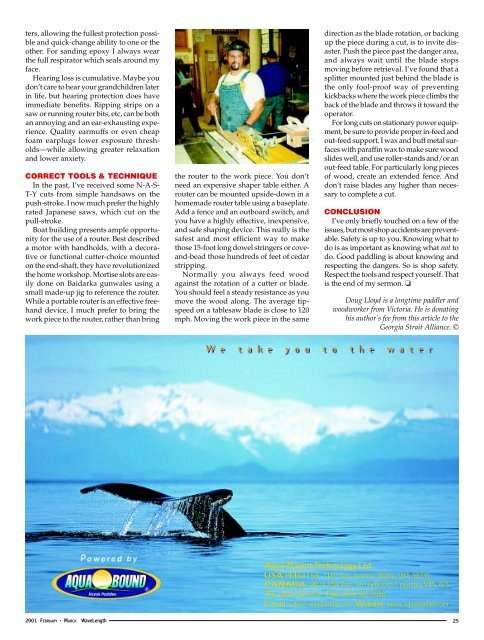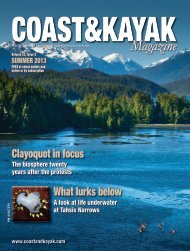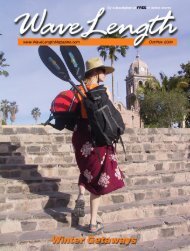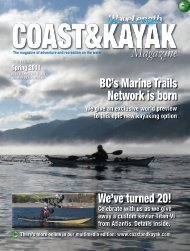Alexandra - Wavelength Paddling Magazine
Alexandra - Wavelength Paddling Magazine
Alexandra - Wavelength Paddling Magazine
Create successful ePaper yourself
Turn your PDF publications into a flip-book with our unique Google optimized e-Paper software.
ters, allowing the fullest protection possible<br />
and quick-change ability to one or the<br />
other. For sanding epoxy I always wear<br />
the full respirator which seals around my<br />
face.<br />
Hearing loss is cumulative. Maybe you<br />
don’t care to hear your grandchildren later<br />
in life, but hearing protection does have<br />
immediate benefits. Ripping strips on a<br />
saw or running router bits, etc, can be both<br />
an annoying and an ear-exhausting experience.<br />
Quality earmuffs or even cheap<br />
foam earplugs lower exposure thresholds—while<br />
allowing greater relaxation<br />
and lower anxiety.<br />
CORRECT TOOLS & TECHNIQUE<br />
In the past, I’ve received some N-A-S-<br />
T-Y cuts from simple handsaws on the<br />
push-stroke. I now much prefer the highly<br />
rated Japanese saws, which cut on the<br />
pull-stroke.<br />
Boat building presents ample opportunity<br />
for the use of a router. Best described<br />
a motor with handholds, with a decorative<br />
or functional cutter-choice mounted<br />
on the end-shaft, they have revolutionized<br />
the home workshop. Mortise slots are easily<br />
done on Baidarka gunwales using a<br />
small made-up jig to reference the router.<br />
While a portable router is an effective freehand<br />
device, I much prefer to bring the<br />
work piece to the router, rather than bring<br />
2001 FEBRUARY • MARCH WaveLength<br />
the router to the work piece. You don’t<br />
need an expensive shaper table either. A<br />
router can be mounted upside-down in a<br />
homemade router table using a baseplate.<br />
Add a fence and an outboard switch, and<br />
you have a highly effective, inexpensive,<br />
and safe shaping device. This really is the<br />
safest and most efficient way to make<br />
those 15-foot long dowel stringers or coveand-bead<br />
those hundreds of feet of cedar<br />
stripping.<br />
Normally you always feed wood<br />
against the rotation of a cutter or blade.<br />
You should feel a steady resistance as you<br />
move the wood along. The average tipspeed<br />
on a tablesaw blade is close to 120<br />
mph. Moving the work piece in the same<br />
direction as the blade rotation, or backing<br />
up the piece during a cut, is to invite disaster.<br />
Push the piece past the danger area,<br />
and always wait until the blade stops<br />
moving before retrieval. I’ve found that a<br />
splitter mounted just behind the blade is<br />
the only fool-proof way of preventing<br />
kickbacks where the work piece climbs the<br />
back of the blade and throws it toward the<br />
operator.<br />
For long cuts on stationary power equipment,<br />
be sure to provide proper in-feed and<br />
out-feed support. I wax and buff metal surfaces<br />
with paraffin wax to make sure wood<br />
slides well, and use roller-stands and/or an<br />
out-feed table. For particularly long pieces<br />
of wood, create an extended fence. And<br />
don’t raise blades any higher than necessary<br />
to complete a cut.<br />
CONCLUSION<br />
I’ve only briefly touched on a few of the<br />
issues, but most shop accidents are preventable.<br />
Safety is up to you. Knowing what to<br />
do is as important as knowing what not to<br />
do. Good paddling is about knowing and<br />
respecting the dangers. So is shop safety.<br />
Respect the tools and respect yourself. That<br />
is the end of my sermon. ❏<br />
Doug Lloyd is a longtime paddler and<br />
woodworker from Victoria. He is donating<br />
his author’s fee from this article to the<br />
Georgia Strait Alliance. ©<br />
25

















